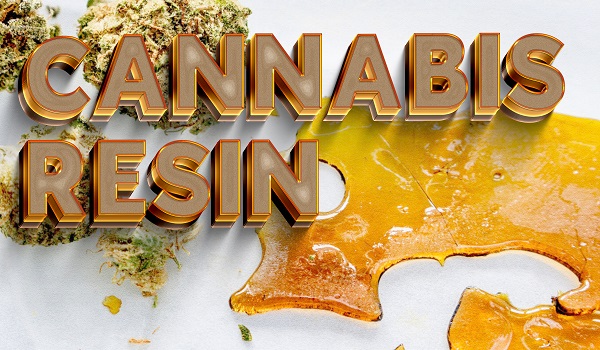Over the past decade, the cannabis industry has advanced significantly technologically, which has contributed to the expansion of cultivation and extraction options. Today, there are many quality extracts on the market that provide cannabis connoisseurs with a full cannabinoid profile while preserving the original essence of the strain.
Among the enthusiast community, there are many methods for extracting certain cannabinoids. However, the cannabis industry uses three main extraction methods:
- Supercritical carbon dioxide
- Hydrocarbon
- Ethanol
In all of these methods, the plant material is treated with a solvent that transfers the active cannabinoids and terpenes from the plant into a chemical solution, followed by purification of impurities and refrigeration. Post-production techniques give the extract a specific texture and consistency.
In this article, we will focus on the progress in terpene preservation and look at live resin. This high quality extract is known for its ideal terpene profile and full spectrum cannabinoid content.
What is a living resin?
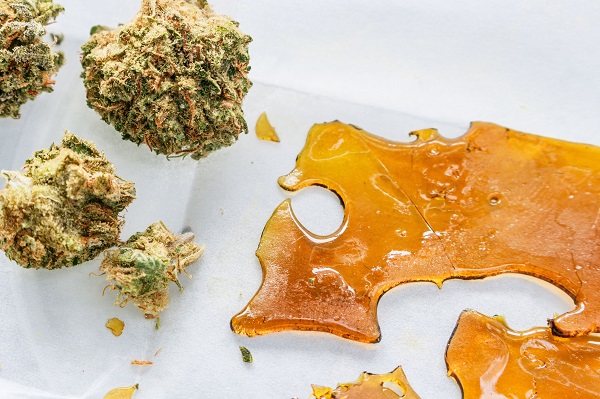
Cannabis extracts are often characterized by their appearance or texture, and this terpene-rich product is no exception. It is called living resin because all of the plant material is cryogenically frozen immediately after harvest, which distinguishes it from classical extraction methods, where the trichomes are aged before being further processed.
The terpenes responsible for flavor and aroma are volatile unsaturated hydrocarbons found in the cannabis plant. Over the years, many cannabis connoisseurs have recognized the importance of preserving terpenes. Since terpenes and cannabinoids break down when exposed to elevated temperatures, trichomes are known to be better extracted at lower temperatures, which helps separate the trichome heads from the plant.
Live resin was first created by a small group of patients in Colorado who were looking for new approaches to preserving complete terpene profiles. These cannabis enthusiasts used a closed butane-based extraction system, which allowed them to maintain the lower temperatures necessary to produce a terpene-rich extract. Thanks to this new method of freshly freezing plants, the live resin is known for its rich flavor and outstanding terpene profiles. In addition, it contains up to 95% THC.
How is live resin produced?
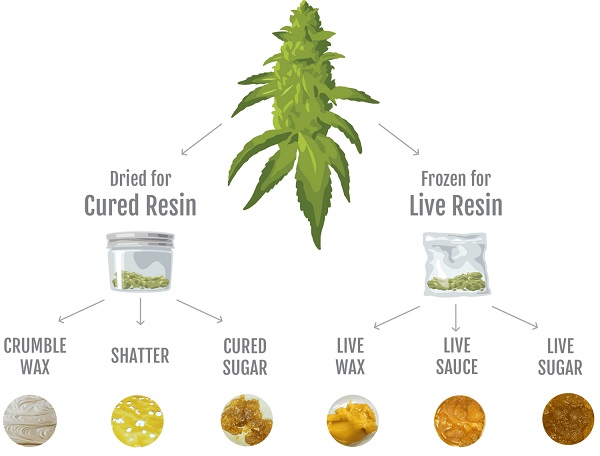
Live resin is produced in many American states where cannabis is regulated by law. Unfortunately, due to EU regulations, it is illegal to purchase or manufacture any cannabis extracts in Europe.
Live resin is produced by licensed extraction experts in state-of-the-art laboratories in regulated U.S. states. Since temperature is key in the cannabis extraction process, the use of high-quality equipment is critical to maintaining the terpene profile.
Here’s a step-by-step description of the process of creating a live resin:
- Quick freeze – plants are immersed in a container filled with liquid nitrogen at -210°C (or sealed in a freezer with dry ice, keeping the temperature at -40°C). Instant freezing of the entire plant immediately after harvesting helps preserve the terpene profile and create an aesthetically pleasing extract.
- Cannabinoid Extraction – solvents (most commonly butane) are used to chemically isolate cannabinoids and terpenes from plant biomass, turning the product into a liquid mixture without disturbing other plant matrices. The solvent must be cooled to below -40 °C, which helps block the water-soluble components of the plant. Live resin can also be produced using non-polar solvents such as ethanol and CO2, but this method is rarely used.
- Extraction with feedback – frozen cannabis is placed in a closed loop hydrocarbon extractor throughout the extraction process. The hydrocarbon and plant extract solution is collected in a collection chamber and heat is used to evaporate the residual solvent from the solution. The remaining oil has to be collected and the remaining solvent will be returned to the tank.
- Cleaning – excess residual solvents are removed from the solution using a vacuum oven at low temperatures, eliminating the risk of unwanted pressure and maintaining an identical terpene profile to the original strain.
- Consistency and texture – post-processing techniques create the unique consistency and texture of live resin. Generally, live resins are dark yellow and very sticky, with a texture similar to wax or gravy. Multiple variations in consistency and texture can be achieved through the use of various cleaning processes, including: «sugar wax», a grainy, sugar-like texture; «raw jelly», sticky and jelly-like; and «sauce», a sticky liquid consistency similar to gravy. Preparation for winter is the process of removing vegetable fat, waxes, and lipids.
How is live resin consumed?

Live resin can be used in many different ways, but because of its sticky texture, it is always recommended to use a dabbing tool when working with it. So, let’s introduce you to the two best methods of consumption.
Application of live resin
Dabbing is the process of applying a small amount of cannabis concentrate to a heated surface where it evaporates on contact. This method has become extremely popular in cannabis culture, and many concentrate enthusiasts use a dub rig to consume live resin.
A dub rig is a compact glass water pipe that resembles a glass bong. However, instead of a bowl like a regular bong, there is a glass or titanium nail that serves as a dabbing surface. The glass unit consists of four key elements: the mouthpiece, the bottom, the body, and the nail.
- The mouthpiece is where the steam is inhaled from. Compared to a standard glass bong it is much smaller.
- The body is the main chamber where the smoke enters before it is inhaled. It is attached to the bottom of the barrel and the mouthpiece and is slightly filled with water to filter the vapor before it is inhaled.
- It attaches to the nail and acts as a passageway for the vaporized concentrate to the main chamber.
Nail
The nail acts as a conductor of heat and concentrates on it. It has a small surface area and can be made of titanium or glass. In contrast, the sausage is made mostly of quartz and looks more like a plate.
After preheating the nail or sausage, the concentrate is applied to their small surface area and vaporized. Usually the nail is left to cool for 30-45 seconds until it reaches optimum temperature, but this can vary depending on the material of the nail.
Dabbing experts often recommend using a quartz thermal nail or a sausage of high quality quartz glass. Quartz retains the full profile of the terpenes and provides efficient and heat stable evaporation. It is an excellent alternative to titanium nails.
Different temperatures are used for dabbing, but the optimal temperature is around 285°C, which preserves the major terpenes and cannabinoids. Low-temperature dubs save concentrates as much as possible and reduce waste, while high-temperature dubs above 350°C can destroy the terpenes profile and destroy all the useful cannabinoids.
However, if you want to reach the perfect temperature every time, an electric nail or e-nail allows you to preset your rig to a specific temperature by using electronic coils to heat the nail or sausage and maximize cannabinoid efficiency.
Steam is drawn into the bottom and passed through the water into the main chamber. After the vapor is filtered through the water, it can be inhaled through a mouthpiece that connects to the main chamber.
Evaporation of live resin
For health-conscious cannabis users, portable vape pens make it easy to consume concentrates.
Wax pens are designed specifically for extracts and can handle the dense texture of a variety of extracts, including shards, sauces, oils and live resins. The wax pen uses an atomizer to heat the concentrate chamber, which is usually made of ceramic. This provides a high-quality vapor that can then be inhaled.
Dry herb vaporizers, such as the Pax 3 and Davinci IQ2, often have a concentrate chamber and are ideal for use with extracts. There are three types of vapes: conductive, convection and hybrid. Which vaporizer is most suitable for live resin?
In a conductive vape, the cannabis comes in direct contact with a heated surface, in this case the concentrate chamber. A convection device directs hot air over and through the dried flowers, and a hybrid device combines both of these methods. With a terpene-rich extract like live resin, the hybrid vape is recommended for optimal flavor.
How to store live resin?
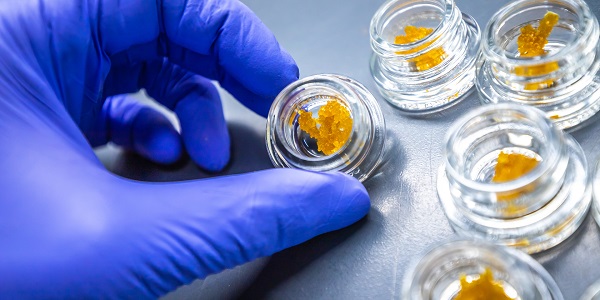
As with all cannabis products, many environmental factors can reduce quality and effectiveness. Some of the most influential factors include the following:
- Direct sunlight.
- High temperature
- High airflow
- High humidity
Over time, oxidation and heat can destroy the crystal and cannabinoid structure. This is why it is always advisable to store your live resin properly.
It is best to store the extracts in a dark place, away from all light, to avoid degradation of the terpene profile and cannabinoid content. Sealed containers allow the live resin to retain its unique terpene profile, protecting it from direct contact with air and moisture.
Cool temperatures are ideal, and storing live resin in a refrigerator in an airtight container is ideal. However, avoid storing directly in the freezer because of the possibility of high humidity in the concentrate container. Freezing any trapped water vapor will create unwanted moisture that can degrade cannabinoid and terpene content.
Content of cannabinoids in live resin
Instead of decomposing cannabinoids over time, the freezing process preserves a whole plant extract with a higher cannabinoid content than other extracts, which is ideal for those seeking the benefits of entourage effects.
The living resin is highly active. With a possible THC content of up to 95%, medical users who want a high THC dose should only consume a minimal amount compared to other extracts.
Terpene profile of live resin
Terpenes can be divided into two groups: sesquiterpenes and monoterpenes. Together, they form the complex terpene profile of the cannabis plant. The monoterpenes are compounds with a smaller molecular structure that are directly responsible for the fresh, invigorating terpenes such as linalool and limonene. Deeper notes provide sesquiterpenes such as caryophyllene and humulene.
Because of their smaller molecular structure, the monoterpenes evaporate first after cannabis is harvested. Cannabis plants contain a higher proportion of sesquiterpenes. In 2015, High Times magazine investigated Michigan Cannabis Cup results and found that live resin was about 2% richer in monoterpenes and contained 11% fewer sesquiterpenes by weight than other extracts.
It is known that terpene levels in inflorescences decrease over time. However, thanks to the complex process of cryogenic freezing, the living resin retains the terpene profile of the plant from the time it is harvested.
A study titled “Composition of Essential Oils of Fresh and Air-Dried Cannabis sativa Cones” indicates that more than 55% of the original terpene profile is lost during the drying and ageing process! Live resin retains terpenes that would have been lost through oxidation throughout the drying and aging process, even before the extraction process begins.
Many other extraction methods negatively affect the terpene profile of the plant. Unfortunately, various solvent-based extraction companies put terpenes lost during the extraction process back into their product after extraction. These artificial terpenes are not produced by the cannabis plant and do not provide the user with the full spectrum of the plant extract. They also affect viscosity, and isolated terpenes are added to reduce the viscosity of the product, which can affect its final appearance.
Live resin production time
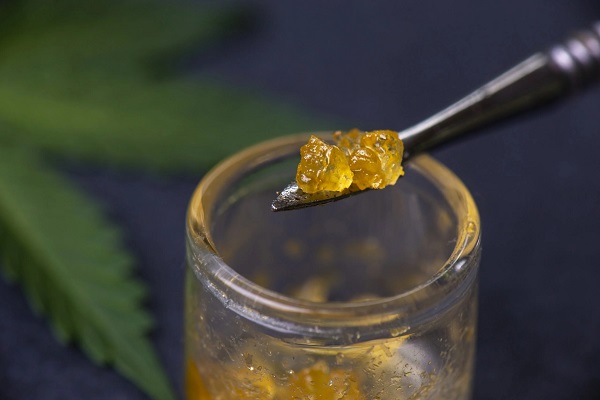
Live resin is also produced faster because there is no need to dry and age the flowers after harvesting. This gives experienced extractors the ability to create more product per year.
However, like all extracts, the terpene profile, texture and aesthetics can vary depending on the quality of the flower, and the final product will be just as good as the frozen flower it was made from.
Is it dangerous to produce live resin?
There have been numerous reports of people at home making BHO-extracts using open loops, with disastrous consequences. It has been said that such amateur methods of “explosion” can cause flammable vapors to build up in enclosed spaces and ignite on contact with sparks.
This can be seen in Colorado, where the number of patients with burns related to BHO production has increased significantly over the past seven years.
It is also important to make sure that the final product is free of residues and solvents. For this reason, it is always advisable to purchase extracts from licensed retailers where all products are lab tested.
Is it expensive?
There have been several reports on the average profitability of dried flowers. Many growers consider a 3-5% yield to be moderate, while high-yielding varieties can make a profit of 7-8%. Because of the limited yield of live resin, products can be expensive.
However, due to the growing demand for high quality extracts, prices have become more affordable for the average US cannabis consumer. Due to the constant fluctuations in the market, it is difficult to determine the exact cost of live resin, but as of this writing, the average price per gram of high quality live resin in the United States ranges from $20 to $60.
What does the future hold?
Some producers prefer to use solvents to extract cannabinoids and terpenes. However, scientists and cannabis enthusiasts continue to push the boundaries of knowledge to create better, cleaner and more effective extracts. Unfortunately, due to the small yield and high preservation of terpenes, live resin is one of the most expensive types of extracts.
Living resin preserves the original terpene profile of the flower, allowing consumers to estimate the exact terpene content of the plant, which cannot be achieved using other extraction methods such as dry sieving and supercritical CO2 extraction.
Although the choice of concentrates depends on individual preference and a wide range is available, if taste is important to you, live resin should be a priority!
Have you tried live resin or had experience with dubbing? Do you think the future of cannabis has to do with extracts, or are they too strong and expensive? Share your opinion in the comments below!

